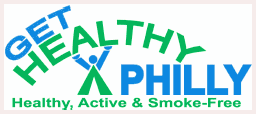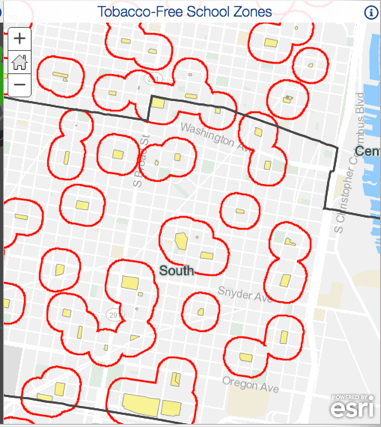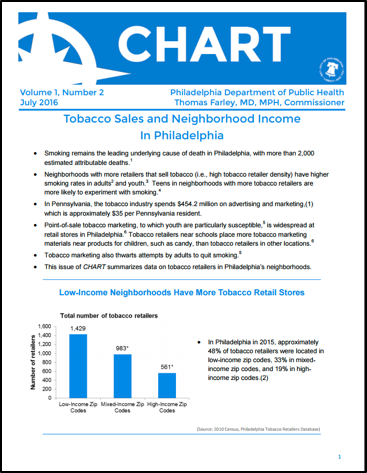Reducing Retailer Density in Philadelphia
In December of 2016, the Philadelphia Board of Health passed new tobacco retailer regulations that will ultimately lead to a reduction in the total number of tobacco retailers in the city, a reduction in the number of retailers near schools, as well as a reduction in disparities in retailer density seen across different neighborhoods. The new regulations set a cap on the total number of tobacco retailer permits, limiting them to 1 per 1,000 people in each planning district. In addition, the regulations restrict any new retailer from locating within 500 feet (or approximately two blocks) of K-12 schools. While current retailers are “grandfathered in” if they are located in a district with a level of retailers already above the new limit or currently located near a school, they can only retain their permit to sell tobacco as long as they renew their permit on time and do not have multiple youth sale violations.
Retailers now face a standardized penalty for selling tobacco to minors: after their third violation in two years, they will be issued a cease tobacco sales order effective for one year. However, if that retailer was located near a school or in a district over the retailer density cap, they will not be able to renew the permit.
The city also increased the annual fee for holding a tobacco sales permit, which funds enforcement efforts, from $50 to $300, bringing Philadelphia’s fee more in line with the fees in other major cities.

We had a chance to talk with the Philadelphia Department of Public Health’s Tobacco Policy and Control Program Manager, Ryan Coffman, and the Philadelphia Department of Public Health’s Tobacco Control Specialist, Melissa Damast, to learn more about why these regulations matter and what went into the Board of Health’s decision to pass them.
Why these policies?
The regulations were developed to address several key issues, but their main goal is to reduce adult and youth smoking.
Issue #1: High rates of youth tobacco use and sales to minors
Factoring in all tobacco product use, the youth tobacco use rate in Philadelphia is over 20%. These regulations provide a strategy to protect youth from factors that encourage them to smoke and from the ultimate consequences of tobacco use. The Board of Health noted that there were too many tobacco retailers that had repeated violations for selling tobacco to minors, despite the City’s efforts at merchant education. In fact, in 2015, 23% of retailers in Philadelphia illegally sold tobacco to individuals under the age of 18, a much higher sales rate than other Pennsylvania communities and higher than the state-wide average of 10.5%
To address these violations, the city realized they needed to enhance their enforcement efforts, meaning both increased compliance checks and improvements to their tobacco retailer database. However, the funds they receive from the Master Settlement Agreement to cover enforcement are diminishing, leaving the city to bear the burden.
The new standardized penalty holds retailers with repeat violations accountable, and the increased fee for a tobacco retailer permit helps fund enforcement efforts.
Issue #2: High tobacco retailer prevalence and disparities in retailer density
Another issue that these regulations aim to address is the sheer number of tobacco retailers in the city (3,500 in June of 2016), and how those retailers are disproportionately located in low-income communities and communities of color. For example, the per capita tobacco retailer density in low-income areas is 69% higher than in high-income areas.
A neighborhood-based retailer cap has the benefit of not only reducing the total number of retailers in the city, but over time, it will also reduce the disparities in retailer density seen across neighborhoods.
Issue #3: Stores near schools, especially in low-income areas
Not only is tobacco retailer density higher in low-income communities and communities of color in Philadelphia – there are also more retailers near schools in these communities as well. Stores in low-income areas have 63% more retailers located within 500 feet of schools than high-income areas.
As seen in a Story Map that the Get Healthy Philly team created, a middle school student in a low-income neighborhood in North Philadelphia passes 16 tobacco retailers along their ¾ mile walk to school. Compare that to a similar walk in a high-income area in Philadelphia, where a middle school student would pass only one retailer on their walk to school.
As Coffman said, “ It is extremely concerning that children who reside in a low-income or community of color in Philadelphia are disproportionately subjected to more tobacco retailers, more tobacco retailers, more retailers near schools and more manipulative industry marketing. This has serious implications for the wellbeing of our children and our communities.”
Recent research has also shown that restricting retailers from locating near schools can also reduce income and race-based disparities in retailer density.
Issue #4: Monitoring and enforcement
In addition to the sheer number of retailers in the city, there are also so many different types of retailers and such a high turnover rate that keeping track of them all for monitoring and enforcement efforts is difficult. Not only do convenience stores, gas stations, and supermarkets in Philadelphia sell tobacco, so do hardware stores, laundromats, and take-out restaurants. In fact, over 450 take-out restaurants sell tobacco products in the city. The cap and increased permit fee were designed to help address this issue, helping to whittle those numbers down as businesses close or change ownership and allowing the city to better monitor and enforce compliance with youth tobacco sales laws.
Get Healthy Philly has also worked with other departments in the city to enhance their tobacco retailer database to increase functionality and make it more user friendly.
Process for Passing the Policies
After the Board of Health gave preliminary approval to the regulations on September 8th, 2016, a 30-day public comment period followed. During this time, the Get Healthy Philly team contacted corner store associations and affected retailers to let them know about the proposed regulations and to make sure they had ample opportunity to voice their opinions and any concerns. The proposed regulations were also published in local newspapers and on the Health Department website. A public hearing was held in late October, and a report was prepared based on comments submitted by the retailers and others. The regulations also received extensive local media coverage throughout the approval process. The Board of Health then met in November to discuss the comments, and made some changes to the regulations based on that feedback. The amended regulations received final approval in December 2016.
Making the Case, Gaining Support
The Board of Health is a panel of health experts and physicians, so the group already understood the devastating effects that tobacco has.
The Board of Health reviewed the high violation rate among tobacco retailers in the city. They reviewed GIS maps and other data that showed the disproportionate burden faced by low-income communities and communities of color.
They also reviewed evidence showing how out of step Philadelphia was with other large cities. Out of the 10 largest US cities, Philadelphia has the highest smoking rate at 23% and prior to the new regulations, Philly’s retailer permit fee was much lower and their retailer density much higher than other cities of similar size. Philadelphia has about 2.2 retailers per 1,000 people, whereas the tobacco retailer density in comparable major cities was approximately 1 per 1,000 people.
The Board also reviewed information on why tobacco retailing matters, including the vast amount of money the tobacco industry spends on marketing in the retail setting and how that marketing works to encourage youth to start smoking and to cue cravings and impulse purchases, making it harder for current smokers to quit. Reducing tobacco retailer density will also mean reducing the presence of tobacco marketing in communities that are currently overburdened.
The regulations also found support in other city leadership – the Philadelphia City Council passed a resolution that voiced their approval of the regulations.
Raising Awareness
 To educate the community and decision makers about the issue, the Health Department released a data brief on tobacco sales and neighborhood income in Philadelphia outlining the issue in terms of tobacco retailer density and tobacco retailer proximity to schools, which helped lay the groundwork for the policies.
To educate the community and decision makers about the issue, the Health Department released a data brief on tobacco sales and neighborhood income in Philadelphia outlining the issue in terms of tobacco retailer density and tobacco retailer proximity to schools, which helped lay the groundwork for the policies.
Get Healthy Philly also created a Story Map – an interactive, visual narrative that connected higher levels of tobacco retailer density (and therefore higher levels of tobacco advertising and marketing) with the higher rates of smoking and smoking attributable deaths found in those same geographic areas.
In addition to outreach efforts to raise awareness about the new regulations among retailers, the Get Healthy Philly team made sure the community at large was aware of the proposed regulations and the issues they are intended to address. They made sure to present the information in particular to the most affected communities – those with higher densities of tobacco retailers and more tobacco retailers near schools.
Various media outlets covered the public hearings and published news stories on the proposed regulations, as well as on the data on disparities in tobacco density in neighborhoods across the city and tobacco retailer proximity to schools.
Retailers can search on the Philadelphia Department of Public Health’s website to see whether they are located within a 500-foot buffer zone around a school, or see what planning district they are located in.
Evaluation
The impact of these new policies will be evaluated through repeated cross-sectional self-report online surveys conducted at baseline and at 12 and 24 months from when the policies go into effect. About 400 people will be included in each wave of the survey, including both smokers and non-smokers. Surveys will be administered to assess frequency and type of tobacco use, degree of tobacco dependence, where tobacco is purchased, distance from home and work to purchase tobacco, length of last quit attempt, urges to purchase tobacco, unplanned purchases, frequency of store visits, and how often participants notice tobacco products.
Update: By 2019, three years after the policy went into effect, the density of tobacco retailers in the city declined by over 20%, with a greater decrease in low-income districts, and the rate of retailers within 500ft of schools declined by 12%.[1]
What else is Philly doing?
The Health Department is also working with the Welcoming Center for New Pennsylvanians and Counter Tools to pilot a voluntary tobacco-free retailer project, working with small businesses to transition away from selling tobacco products without losing revenue (e.g. by replacing tobacco products with healthy foods). Learn more here.
Interested in passing similar policies in your community and want to learn more? Contact Ryan Coffman (ryan.coffman@phila.gov) or Melissa Damast (melissa.damast@phila.gov).



